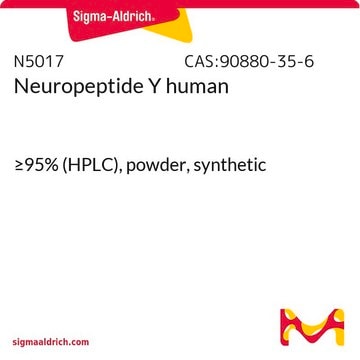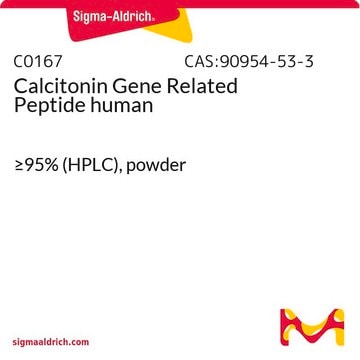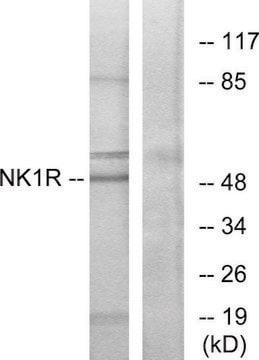05-23-0600
Substance P
Neuropeptide found in high concentrations in the gut.
Sinónimos:
Substance P, Neurokinin P, RPKPQQFFGLM, SP
About This Item
Productos recomendados
Nivel de calidad
Análisis
≥96% (HPLC)
formulario
solid
fabricante / nombre comercial
Calbiochem®
condiciones de almacenamiento
OK to freeze
desiccated (hygroscopic)
color
white
solubilidad
5% acetic acid: 1 mg/mL
Condiciones de envío
ambient
temp. de almacenamiento
−20°C
InChI
1S/C63H98N18O13S/c1-37(2)33-45(57(89)74-41(53(68)85)27-32-95-3)73-52(84)36-72-54(86)46(34-38-15-6-4-7-16-38)78-58(90)47(35-39-17-8-5-9-18-39)79-56(88)42(23-25-50(66)82)75-55(87)43(24-26-51(67)83)76-59(91)49-22-14-31-81(49)62(94)44(20-10-11-28-64)77-60(92)48-21-13-30-80(48)61(93)40(65)19-12-29-71-63(69)70/h4-9,15-18,37,40-49H,10-14,19-36,64-65H2,1-3H3,(H2,66,82)(H2,67,83)(H2,68,85)(H,72,86)(H,73,84)(H,74,89)(H,75,87)(H,76,91)(H,77,92)(H,78,90)(H,79,88)(H4,69,70,71)/t40-,41-,42-,43-,44-,45-,46-,47-,48-,49-/m0/s1
Clave InChI
ADNPLDHMAVUMIW-CUZNLEPHSA-N
Descripción general
Aplicación
Acciones bioquímicas o fisiológicas
Substance P receptors
Envase
Advertencia
Secuencia
Forma física
Reconstitución
Otras notas
Chiwakata, C.B., et al. 1996. Infect. Immun. 64, 5106.
Tanabe, T., et al. 1996. Eur. J. Pharmacol. 299, 187.
Heath, M.J., et al. 1994. J. Neurophysiol. 72, 1192.
Zhu, J., et al. 1994. Eur. J. Pharmacol. 268, 279.
Garland, A.M., et al. 1993. Soc. Neurosci. 19, Abstract 104.6.
Wei, J.Y., et al. 1993. Soc. Neurosci. 19, Abstract 136.14.
Información legal
Código de clase de almacenamiento
11 - Combustible Solids
Clase de riesgo para el agua (WGK)
WGK 1
Punto de inflamabilidad (°F)
Not applicable
Punto de inflamabilidad (°C)
Not applicable
Certificados de análisis (COA)
Busque Certificados de análisis (COA) introduciendo el número de lote del producto. Los números de lote se encuentran en la etiqueta del producto después de las palabras «Lot» o «Batch»
¿Ya tiene este producto?
Encuentre la documentación para los productos que ha comprado recientemente en la Biblioteca de documentos.
Nuestro equipo de científicos tiene experiencia en todas las áreas de investigación: Ciencias de la vida, Ciencia de los materiales, Síntesis química, Cromatografía, Analítica y muchas otras.
Póngase en contacto con el Servicio técnico

![[Tyr8]-Substance P](/deepweb/assets/sigmaaldrich/product/images/285/126/cecdabab-b085-499e-acc5-94ab5ca9bb92/640/cecdabab-b085-499e-acc5-94ab5ca9bb92.jpg)






